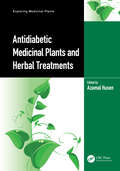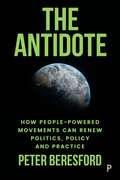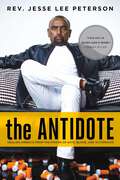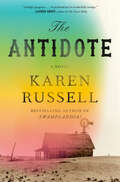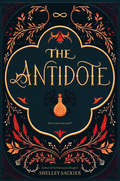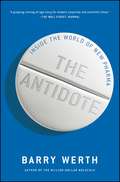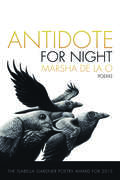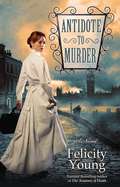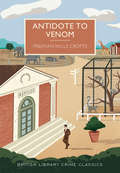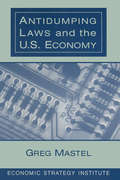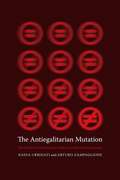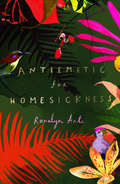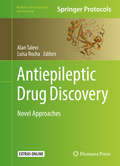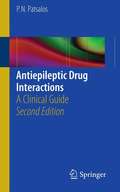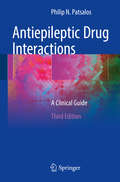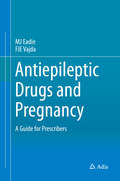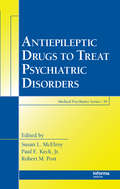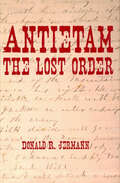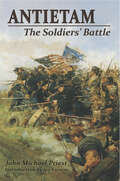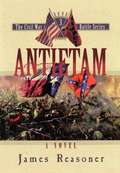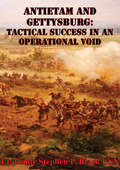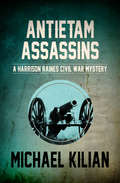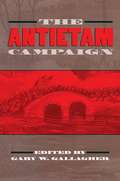- Table View
- List View
Antidiabetic Medicinal Plants and Herbal Treatments (Exploring Medicinal Plants)
by Azamal HusenDiabetes is a chronic condition associated with metabolic disorder. Persons suffering from diabetes have shown accelerated levels of blood sugar which often harms the heart, blood vessels, eyes, kidneys, and nerves. Over the past few decades, the prevalence of diabetes has been progressively increasing. Synthetic drugs are used to treat diabetic patients to help control the disorder, but it is shown that numerous medicinal plants and herbal drugs are widely used in several traditional systems of medicine to prevent and treat diabetes. They are reported to produce beneficial effects in combating diabetes and alleviating diabetes-related complications. These plants contain phtyonutrients and phytoconstituents demonstrating protective or disease preventive properties. In many developing countries, herbal drugs are recommended by traditional practitioners for diabetes treatment because the use of synthetic drugs is not affordable.Key Features: Provides botanical descriptions, distribution, and pharmacological investigations of notable medicinal and herbal plants used to prevent or treat diabetes Discusses phytochemical and polyherbal formulations for the management of diabetes and other related complications Contains reports on antidiabetic plants and their potential uses in drug discovery based on their bioactive molecules This volume in the Exploring Medicinal Plants series provides an overview of natural healing treatments in selected antidiabetic plants. The book presents valuable information to scientists, researchers, and students working with medicinal plants or for those specializing in areas of ethnobotany, natural products, pharmacognosy, and other areas of allied healthcare. It is also useful to pharmaceutical companies, industrialists, and health policy makers.
The Antidote: How People-Powered Movements Can Renew Politics, Policy and Practice
by Peter BeresfordThe gap between personal and formal politics has been widening globally and locally. As personal politics have become more inclusive and egalitarian inspired by new social movements, neoliberal ideologies have undermined democracy, increasing isolation, inequality, poverty, disease and environmental threat. Yet this paradox may also offer a path to transformation. Using international evidence and examples, The Antidote explores what we can learn from the equalisation of personal roles and relationships that’s been taking place, to help us reconnect with ourselves and each other and make possible more participatory and liberatory policy and politics. It sets out the barriers we face and offers a route map to bring an end to the destructive effects of unfettered neoliberal ideology, economics, policy and politics.
The Antidote: Healing America From the Poison of Hate, Blame, and Victimhood
by Jesse Lee PetersonReverend Jesse Lee Peterson explains that this noxious, blaming mind-set has destroyed the black family, magnified racial tensions, pitted women against men, and quashed a sense of paternal responsibility—which in essence has killed the soul of the black community.For a half-century or more, black people have labored under the spell of what Jesse Lee Peterson calls the "alchemists." These are the race hustlers, media hacks, politicians, community organizers, and the like who promise to "fundamentally transform" America. The transformation they promise, however, produces only fool's gold—unearned benefits like welfare, food stamps, subsidized housing, payouts from lawsuits, and maybe one day even "reparations." Worse, to secure these counterfeit goods, recipients have to sacrifice something of infinite value: the sanctity of the two-parent family. It is a devil's bargain. In The Antidote: Healing America from The Poison of Hate, Blame, and Victimhood, Reverend Jesse Lee Peterson explains that this noxious, blaming mind-set has destroyed the black family, magnified racial tensions, pitted women against men, and quashed a sense of paternal responsibility—which in essence has killed the soul of the black community. The antidote to this poison has the power to save America and can be found inside this book. Now is the time to reject the culture of blame and find the antidote—it can save your life, your family, and your future.
The Antidote: A Novel
by Karen RussellFrom Pulitzer finalist, MacArthur Fellowship recipient, and bestselling author of Swamplandia! and Vampires in the Lemon Grove Karen Russell: a gripping dust bowl epic about five characters whose fates become entangled after a storm ravages their small Nebraskan townThe Antidote opens on Black Sunday, as a historic dust storm ravages the fictional town of Uz, Nebraska. But Uz is already collapsing—not just under the weight of the Great Depression and the dust bowl drought but beneath its own violent histories. The Antidote follows a "Prairie Witch,&” whose body serves as a bank vault for peoples&’ memories and secrets; a Polish wheat farmer who learns how quickly a hoarded blessing can become a curse; his orphan niece, a basketball star and witch&’s apprentice in furious flight from her grief; a voluble scarecrow; and a New Deal photographer whose time-traveling camera threatens to reveal both the town&’s secrets and its fate.Russell's novel is above all a reckoning with a nation&’s forgetting—enacting the settler amnesia and willful omissions passed down from generation to generation, and unearthing not only horrors but shimmering possibilities. The Antidote echoes with urgent warnings for our own climate emergency, challenging readers with a vision of what might have been—and what still could be.
The Antidote
by Shelley SackierFrom the author of The Freemason’s Daughter comes a lush romantic fantasy perfect for fans of Everless!In the world of healers, there is no room for magic.Fee knows this, just as certainly as she knows that her magic must be kept secret. But the crown prince Xavi, Fee’s best friend and only source of comfort, is sick. So sick, that Fee can barely contain the magic lying dormant inside her. She could use it, just a little, to heal him. But magic comes at a deadly cost—and attracts those who would seek to snuff it out forever. A wisp of a spell later, Fee finds herself caught in a whirl of secret motivations and dark pasts, where no one is who—or what—they appear to be. And saving her best friend means delving deeper into the tempting and treacherous world whose call she’s long resisted—uncovering a secret that will change everything. Laini Taylor meets Sara Holland in this lavish fantasy from lauded historical romance author Shelley Sackier!
The Antidote: Inside the World of New Pharma
by Barry WerthIN THE ANTIDOTE, Barry Werth draws upon unprecedented inside reporting spanning more than two decades to provide a groundbreaking closeup of the upstart pharmaceutical company Vertex and the ferocious but indispensable world of Big Pharma that it inhabits. In 1989, the charismatic Joshua Boger left Merck, then America's most admired business, to found a drug company that would challenge industry giants and transform health care. Werth described the company's tumultuous early days during the AIDS crisis in The Billion-Dollar Molecule, a celebrated classic of science and business journalism. Now he returns to tell a riveting story of Vertex's bold endurance and eventual success. The $325 billion-a-year pharmaceutical business is America's toughest and one of its most profitable. It's riskier and more rigorous at just about every stage than any other business, from the towering biological uncertainties inherent in its mission to treat disease; to the 30-to-1 failure rate in bringing out a successful medicine even after a molecule clears all the hurdles to get to human testing; to the multibillion-dollar cost of ramping up a successful product; to operating in the world's most regulated industry, matched only by nuclear power. Werth captures the full scope of Vertex's twentyfive- year drive to deliver breakthrough medicines. At a time when America struggles to maintain its innovative edge, The Antidote is a powerful inside look at one of the most intriguing and important business stories of recent decades.
The Antidote for Everything
by Kimmery MartinIn this whip-smart and timely novel from acclaimed author Kimmery Martin, two doctors travel a surprising path when they must choose between treating their patients and keeping their jobs. Georgia Brown&’s profession as a urologist requires her to interact with plenty of naked men, but her romantic prospects have fizzled. The most important person in her life is her friend Jonah Tsukada, a funny, empathetic family medicine doctor who works at the same hospital in Charleston, South Carolina and who has become as close as family to her. Just after Georgia leaves the country for a medical conference, Jonah shares startling news. The hospital is instructing doctors to stop providing medical care for transgender patients. Jonah, a gay man, is the first to be fired when he refuses to abandon his patients. Stunned by the predicament of her closest friend, Georgia&’s natural instinct is to fight alongside him. But when her attempts to address the situation result in incalculable harm, both Georgia and Jonah find themselves facing the loss of much more than their careers.
Antidote for Night
by Marsha de la OSet in present-day Southern California, Antidote for Night is a heartbreak lyric, a corrido, a love song to California's city lights and far-flung outskirts—the San Diego backcountry, the Central Valley, the Inland Empire, and the Mojave Desert. Marsha de la O's voice is a kind of free jazz, musically rich with LA noir and the vastness of metropolitan Southern California.Marsha de la O's Black Hope won the New Issues Prize from the University of Western Michigan and an Editor's Choice Award. She has taught Spanish-speaking children in Los Angeles and Ventura County for thirty years.
Antidote to Murder
by Felicity YoungIn the scorching summer of 1911, London is a hotbed of political activity as women fight for their equality and Germany starts to pose a dangerous threat. But Dody McCleland, England's first female autopsy surgeon, has more immediate concerns--such as finding out who's trying to frame her for murder... A distraught scullery maid appears at Dody's Women's Clinic begging for an abortion. It turns out she has a case of lead poisoning, which Dody believes she took to induce a miscarriage. Instead of reporting the girl to the authorities, Dody decides to council her and prescribes an antidote. But days later, the maid is found dead from a bungled criminal abortion--and the coroner receives a series of anonymous letters accusing Dody of the crime. Now, Dody has to find out who has framed her for the maid's murder--or else she'll be embroiled in a criminal trial. Chief Inspector Pike is working undercover on another case, playing the piano for an exotic dancer who may be spying for the Germans, but when he hears Dody's in trouble, he insists on lending a hand. But as Pike and Dody are about to discover, she's not only fighting for her career, but for her life, too...
Antidote to Venom: A British Library Crime Classic (British Library Crime Classics #0)
by Freeman Wills Crofts'Mr Wills Crofts is deservedly a first favourite with all who want a real puzzle’ – Times Literary Supplement 'He always manages to give us something that really keeps us guessing’ – Daily Mirror George Surridge, director of the Birmington Zoo, is a man with many worries: his marriage is collapsing; his finances are insecure; and an outbreak of disease threatens the animals in his care. As Surridge’s debts mount and the pressure on him increases, he begins to dream of miracle solutions. But is he cunning enough to turn his dreams into reality – and could he commit the most devious murder in pursuit of his goals? This ingenious crime novel, with its unusual 'inverted’ structure and sympathetic portrait of a man on the edge, is one of the greatest works by this highly respected author. The elaborate means of murder devised by Crofts’s characters is perhaps unsurpassed in English crime fiction for its ostentatious intricacy. This new edition is the first in several decades and includes an introduction by the award-winning novelist and crime fiction expert Martin Edwards.
Antidumping Laws and the U.S. Economy
by Greg MastelThis volume reviews the goals, operation, and history of American antidumping laws coupled with a strategy for using those laws to promote U.S. trade policy and economic objectives in the post-Uruguay Round GATT talks.
The Antiegalitarian Mutation: The Failure of Institutional Politics in Liberal Democracies
by Nadia Urbinati Arturo ZampaglioneThe twin crises of immigration and mass migration brought new urgency to the balance of power between progressive, humanitarian groups and their populist opponents. In the United States and many European countries, the outcome of this struggle is uncertain, with a high chance that the public will elect more politicians who support an agenda of nativism and privatization. The Antiegalitarian Mutation makes a forceful case that those seeking to limit citizenship and participation, political or otherwise, have co-opted democracy. Political and legal institutions are failing to temper the interests of people with economic power against the needs of the many, leading to an unsustainable rise in income inequality and a new oligarchy rapidly assuming broad social control. For Nadia Urbinati and Arturo Zampaglione, this insupportable state of affairs is not an inevitable outcome of robust capitalism but rather the result of an ideological war waged against social democracy by the neoliberal governments of Reagan, Thatcher, and others. These giants of free-market fundamentalism secured power through legitimate political means, and only by taking back our political institutions can we remedy the social ills that threaten to unmake our world. That, according to The Antiegalitarian Mutation, is democracy's challenge and its ongoing promise.
Antiemetic for Homesickness
by Romalyn Ante*Longlisted for the Swansea University Dylan Thomas prize 2021**Shortlisted for the Jhalak Prize 2021: A 'tour-de-force'**An Irish Times and Poetry School Book of the Year 2020*'A day will come when you won't missthe country na nagluwal sa 'yo.'- 'Antiemetic for Homesickness'The poems in Romalyn Ante's luminous debut build a bridge between two worlds: journeying from the country 'na nagluwal sa 'yo' - that gave birth to you - to a new life in the United Kingdom. Steeped in the richness of Filipino folklore, and studded with Tagalog, these poems speak of the ache of assimilation and the complexities of belonging, telling the stories of generations of migrants who find exile through employment - through the voices of the mothers who leave and the children who are left behind. With dazzling formal dexterity and emotional resonance, this expansive debut offers a unique perspective on family, colonialism, homeland and heritage: from the countries we carry with us, to the places we call home.'Moving, witty and agile' Observer'By turns playful and tender, offering a formally-various exploration of migration, community, and nursing... there is honesty, musicality, a powerful heart' Irish Times
Antiepileptic Drug Discovery: Novel Approaches (Methods in Pharmacology and Toxicology)
by Luisa Rocha Alan TaleviThis thorough volume delves into antiepileptic drug discovery with a comprehensive collection of innovative approaches for the development of antiepileptic therapies, focusing on novel molecular targets for antiepileptic drugs, computer-aided approaches for the identification of new drug candidates, and therapeutic strategies to overcome refractory epilepsy. The last section illustrates the potential benefits that network pharmacology and rational drug repurposing could bring to the antiepileptic drug discovery community. Written for the "Methods in Pharmacology and Toxicology" series, chapters include the kind of detailed description and implementation advice to ensure results in the laboratory. Authoritative and practical, "Antiepileptic Drug Discovery: Novel Approaches" aims to provide medicinal chemists, pharmacologists, and other researchers with the tools need to further explore the study of pharmacoresistant epilepsy and the discovery of new antiepileptic drugs.
Antiepileptic Drug Interactions, Second Edition: A Clinical Guide
by Philip PatsalosAntiepileptic Drug Interactions: A Clinical Guide, Second Edition provides a pocket-sized, systematic description of the most clinically relevant drug interactions that occur between AEDs and also between AEDs and non-AEDs. AEDs are presented alphabetically and by drug class in three sections for easy access: Drug interactions between AEDs; Drug interactions between AEDs and non-AEDs: Interactions affecting AEDs; and Drug interactions between AEDs and non-AEDs: Interactions affected by AEDs. Antiepileptic Drug Interactions: A Clinical Guide, Second Edition should help physicians make more rational choices when polytherapy regimens are indicated and should be of interest to all who treat patients with epilepsy: neurologists and neurosurgeons, trainees at all levels, general practitioners and epilepsy nurse specialists.
Antiepileptic Drug Interactions, Third Edition: A Clinical Guide
by Philip N. PatsalosThis updated third edition of a successful book is a description of both pharmacokinetic and pharmacodynamic antiepileptic drug (AED) interactions, including details of the magnitude and mechanism of interactions, and also of drug combinations that are not associated with interactions and therefore can be coprescribed without undue concern. Presented in alphabetical order and by drug class, drug interactions that occur between AEDs and also between AEDs and non-AEDs are described in three sections: Drug interactions between AEDs; Drug interactions between AEDs and non-AED Drugs: Interactions affecting AEDs; Drug interactions between AEDs and non-AED Drugs: Interactions affected by AEDs. Antiepileptic Drug Interactions: A Clinical Guide, 3rd Edition with its clear, concise and unambiguous content will allow physicians and allied health professionals to make more rational choices when AED polytherapy regimens are indicated. There is always a choice and avoiding highly interacting drugs and choosing drug combinations that are minimally interacting or do not interact should be the goal in treating patients with epilepsy. This book provides all the necessary information so as to allow this goal to be achieved and, if necessary, to aid effective management of AED interactions.
Antiepileptic Drugs and Pregnancy: A Guide for Prescribers
by Mj Eadie Fje VajdaA description of our current understanding of antiepileptic drug use during pregnancy, this book includes chapters on the impact of seizures on the mother and developing child, changes in maternal physiology during pregnancy and its impact on drug disposition, and the pharmacokinetic differences between the various anti-seizure medications. It also deals with the possible harmful effects of antiepileptic drug exposure during pregnancy on the physical and intellectual development of the fetus. Clinicians have to balance the potential adverse effects of the medicine for the fetus and mother-to-be against the risks that uncontrolled seizures hold for both when treating pregnant women with antiepileptic drugs. Only recently have enough scientific data emerged to provide a rational basis for treatment decisions that take in both aspects. This work provides a single, accessible and up-to-date resource for busy clinicians.
Antiepileptic Drugs to Treat Psychiatric Disorders (Medical Psychiatry Series)
by Susan L. McElroy Paul E. Keck Robert M. PostSeveral antiepileptic drugs (AEDs) now have regulatory indications for treating bipolar disorder. There is growing evidence that AEDs in general have a variety of useful psychotropic effects. Antiepileptic Drugs to Treat Psychiatric Disorders is the first comprehensive, clinically oriented reference on the use of AEDs to treat a variety of psychiat
Antietam: The Lost Order
by Captain Donald R. Jermann&“This accessible narrative describes the impact of the discovery of this lost order on the pivotal Battle of Antietam.&” —Book News Inc. &“This book is not a dry history book but instead quite lively as it presents the story of the lost order and the events surrounding it, and it is highly recommended to Civil War enthusiasts.&”—Curledup.com Under an unfortunate set of circumstances on September 13, 1862, the Confederates lost and the Union recovered a copy of Confederate battle plan Special Order 191. &“If I can&’t beat Bobby Lee with this piece of paper, I will be willing to go home,&” said Union army leader George B. McClellan upon reading the document. Antietam: The Lost Order covers the hours between the time McClellan read Lee&’s plan and Lee&’s army reunited. Thirty-seven maps display the tactics employed as the clock ticked from September 9 to September 19, including Harper&’s Ferry defenses, McLaw&’s Brigade deployments, relief routes for Harper&’s Ferry, the Battle of Maryland Heights, and other significant plans and battles. Antietam: The Lost Order explains why Harper&’s Ferry was key to the Union victory in September 1862, the importance of the location and timing of the Battle of Antietam, and how its outcome influenced the future of our country. The book concludes by analyzing what went wrong on the Union side, the lasting impact of finding the lost order, and finally, the fates of the major players. With as much emphasis given to human foibles as to troop movements, this book will appeal to a wide audience beyond Civil War devotees.
Antietam: The Soldiers' Battle
by Jay Luvaas John Michael Priest“The best battlefield first-person compilation I have read . . . Here it all is—the tactics, the movement, the truth about warfare.” —The Civil War TimesIn Antietam: The Soldiers’ Battle, historian John Michael Priest tells this brutal tale of slaughter from an entirely new point of view: that of the common enlisted man. Concentrating on the days of actual battle—September 16, 17, and 18, 1862—Priest vividly brings to life the fear, the horror, and the profound courage that soldiers displayed, from the first Federal cavalry probe of the Confederate lines to the last skirmish on the streets of Sharpsburg. Antietam is not a book about generals and their grand strategies, but rather concerns men such as the Pennsylvanian corporal who lied to receive the Medal of Honor; the Virginian who lay unattended on the battlefield through most of the second day of fighting, his arm shattered from a Union artillery shell; the Confederate surgeon who wrote to the sweetheart he left behind enemy lines in Harrisburg, Pennsylvania that he had seen so much death and suffering that his “head had whitened and my very soul turned to stone.”Besides being a gripping tale charged with the immediacy of firsthand accounts of the fighting, Antietam also dispels many misconceptions long held by historians and Civil War buffs alike. Seventy-two detailed maps—which describe the battle in the hourly and quarter-hourly formats established by the Cope Maps of 1904—together with rarely-seen photographs and his own intimate knowledge of the Antietam terrain, allow Priest to offer a substantially new interpretation of what actually happened.
Antietam (The Civil War Battle Series, Book #3)
by James Reasoner[From the back cover] Will glanced at the cornfield to his right and saw the hail of bullets cutting through the growth, knocking ears of corn from their stalks and making the plants sway as if a wind were blowing over them. It was a wind of death, thought Will, and that was all he had time to think before the Federals were upon them. He emptied his pistol at almost point-blank range as the leading edge of the Union attack reached the trees. Around him, the men of his company could hold back no longer. With Rebel yells sounding from their throats, they leaped forward, firing their rifles, thrusting with bayonets, slashing with rifle butts. The two sides came together with an audible crash. Grunts of exertion mingled with shrieks of pain. Men who tripped and fell were trampled ruthlessly underfoot by friend and foe alike. Will pulled his saber from its scabbard. His training in its use had been rudimentary at best, but he knew how to hack back and forth with the blade. As he fought, his senses alternated between a heightened awareness and a dull numbness. There were moments that were crystal clear, etched in his memory for the rest of his life: the open, shouting mouth of a Union soldier lunging at him, the bitter stench of powder smoke in his nose, the burning pain of a bullet that grazed his left shoulder and tore his uniform but left only a red mark on his flesh. At other times he seemed surrounded by a fog that pressed in on him so that the figures around him were blurry and the sounds of battle only a distant din. But always he fought, striking out at anyone in a blue uniform. Something brushed his face, and he realized it was a corn tassel. He had stumbled into the field without knowing it. All around him the plants were falling, some of the stalks cut down by flying bullets, others toppled by the bodies of men as they fell, the wounded, the dead, and the dying. Green was splashed with crimson and then crushed into the earth.
Antietam And Gettysburg: Tactical Success In An Operational Void
by Lt.-Cmdr Stephen P. Black USNThe Battles of Antietam and Gettysburg are widely recognized as tactical victories for the Union's Army of the Potomac. Following both battles, however, the respective commanding generals. General McClellan and General Meade, were sharply criticized for having failed to vigorously pursue General Lee and his Army of Northern Virginia in order to deliver a decisive blow. Both Union commanders offered a list of extenuating circumstances, such as battle fatigue, large casualties and lack of supplies, which precluded a "premature" pursuit of General Lee.Upon examination, however, their inability to conceptualize a decisive pursuit of General Lee's army points to a direct failure at the operational level of War. Both Union generals were unable to link their tactical victories to any larger strategic objective. The reasons for this from the strategic confusion of a conflict evolving from limited War to total War, and from the void in operational training that left both McClellan and Meade ill prepared to perform successfully at this critical level of Warfare.Examining this operational void, it becomes apparent that a commander's construct of War must be complete, that is, fully cognizant of the strategic, operational and tactical levels of War, in order to achieve success beyond the limits of the tactical battlefield. Such an examination points to the criticality of the operational level of Warfare, highlights the importance of the commander's concept of operations and suggests that an operational commander must grow in the sense that his cognitive processes must be tuned into the dynamics of his environment, not only on a tactical level, but on the operational and strategic level.
Antietam Assassins (The Harrison Raines Civil War Mysteries #6)
by Michael KilianA Civil War spy is pulled out of retirement to find a killer It's 1862, and for Harrison Raines, the Civil War is finished. Since the First Battle of Bull Run, he has served the Union Army as a spy, crisscrossing the war-torn country and witnessing more death, misery, and carnage than any man should. Although a Virginian, he loathes slavery, and is proud to have served Abraham Lincoln. But Raines has had enough killing, and wishes only to retire to a tranquil patch of land. He acquires a plot in the hills of western Virginia and settles down to the life of the gentleman farmer--but Raines's days will not remain quiet for long. When a local parson known to have Union sympathies is killed, Raines fears his new neighbors may come after him next. To secure a peaceful retirement, he will have to stare down death 1 last time. The Antietam Assassins is the 6th book in the Harrison Raines Civil War Mysteries, but you may enjoy reading the series in any order.
The Antietam Campaign
by Gary W. GallagherThe Maryland campaign of September 1862 ranks among the most important military operations of the American Civil War. Crucial political, diplomatic, and military issues were at stake as Robert E. Lee and George B. McClellan maneuvered and fought in the western part of the state. The climactic clash came on September 17 at the battle of Antietam, where more than 23,000 men fell in the single bloodiest day of the war.Approaching topics related to Lee's and McClellan's operations from a variety of perspectives, contributors to this volume explore questions regarding military leadership, strategy, and tactics, the impact of the fighting on officers and soldiers in both armies, and the ways in which participants and people behind the lines interpreted and remembered the campaign. They also discuss the performance of untried military units and offer a look at how the United States Army used the Antietam battlefield as an outdoor classroom for its officers in the early twentieth century.The contributors are William A. Blair, Keith S. Bohannon, Peter S. Carmichael, Gary W. Gallagher, Lesley J. Gordon, D. Scott Hartwig, Robert E. L. Krick, Robert K. Krick, Carol Reardon, and Brooks D. Simpson.[for catalog, in place of 3rd paragraph]]The contributors: William A. BlairKeith S. BohannonPeter S. CarmichaelGary W. GallagherLesley J. GordonD. Scott HartwigRobert E. L. KrickRobert K. KrickCarol ReardonBrooks D. Simpson-->The Maryland campaign of September 1862 ranks among the most important military operations of the American Civil War. The climactic clash came on September 17 at the battle of Antietam, where more than 23,000 men fell in the single bloodiest day of the war. Exploring topics related to Lee's and McClellan's operations from a variety of perspectives, contributors to this volume examine questions of military leadership, strategy, and tactics; the performance of untried military units; and the ways in which the battle has been remembered. The contributors are William A. Blair, Keith S. Bohannon, Peter S. Carmichael, Gary W. Gallagher, Lesley J. Gordon, D. Scott Hartwig, Robert E. L. Krick, Robert K. Krick, Carol Reardon, and Brooks D. Simpson. The editor is Gary W. Gallagher.-->
